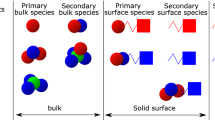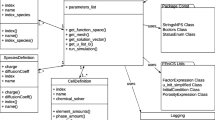Abstract
ReactMiCP, a new reactive transport simulator was developed based on the semismooth speciation solver SpecMiCP. Its main feature is a sequential iterative operator splitting algorithm where macroscopic model parameters are explicitly included in the formulation. Its correctness, robustness, and efficiency are tested against the MoMaS benchmark and two sets of cement paste lab experiments. We show that a robust speciation solver is a key requirement for good performance of the reactive transport simulator. We also demonstrate that a sequential iterative solver should be preferred over non-iterative solvers when using operator splitting. The flexibility and the speed of the simulator are used to test the influence of the database, the initial condition, and the diffusion coefficient model for the cement paste simulations.
Similar content being viewed by others
References
Amdahl, G.M.: Validity of the single processor approach to achieving large scale computing capabilities. In: Proceedings of the April 18-20, 1967, Spring Joint Computer Conference, ACM, New York, NY, USA, AFIPS ’67 (Spring), pp 483–485 (1967). doi:10.1145/1465482.1465560
Bary, B., Sellier, A.: Coupled moisture–carbon dioxide–calcium transfer model for carbonation of concrete. Cement Concret. Res. 34(10), 1859–1872 (2004). doi:10.1016/j.cemconres.2004.01.025
Bernabé, Y., Mok, U., Evans, B.: Permeability-porosity relationships in rocks subjected to various evolution processes. In: Kümpel, HJ (ed.) Thermo-Hydro-Mechanical Coupling in Fractured Rock, Pageoph Topical Volumes, pp 937–960, Birkhäuser Basel (2003). doi:10.1007/978-3-0348-8083-1_9
Bethke, C.: Geochemical and biogeochemical reaction modeling. Cambridge University Press, Cambridge (2008)
Brunet, J.P.L., Li, L., Karpyn, Z.T., Kutchko, B.G., Strazisar, B., Bromhal, G.: Dynamic evolution of cement composition and transport properties under conditions relevant to geological carbon sequestration. Energy Fuels 27(8), 4208–4220 (2013). doi:10.1021/ef302023v
Carrayrou, J.: Looking for some reference solutions for the reactive transport benchmark of MoMaS with SPECY. Comput. Geosci. 14(3), 393–403 (2010). doi:10.1007/s10596-009-9161-y
Carrayrou, J., Mosé, R, Behra, P.: Operator-splitting procedures for reactive transport and comparison of mass balance errors. J. Contam. Hydrol. 68(3–4), 239–268 (2004). doi:10.1016/S0169-7722(03)00141-4
Carrayrou, J., Hoffmann J, Knabner, P., Kräutle, S., De Dieuleveult, C., Erhel, J., der Lee, J.V., Lagneau, V., Mayer, K.U., MacQuarrie, K.T.: Comparison of numerical methods for simulating strongly nonlinear and heterogeneous reactive transport problems—the MoMaS benchmark case. Comput. Geosci. 14(3), 483–502 (2010a). doi:10.1007/s10596-010-9178-2
Carrayrou, J., Kern, M., Knabner, P.: Reactive transport benchmark of MoMaS. Comput. Geosci. 14 (3), 385–392 (2010b). doi:10.1007/s10596-009-9157-7
Dagum, L., Menon, R.: OpenMP: an industry standard API for shared-memory programming. IEEE Comput. Sci. Eng. 5(1), 46–55 (1998)
Dilnesa, B., Wieland, E., Lothenbach, B., Dähn, R., Scrivener, K.: Fe-containing phases in hydrated cements. Cement Concret. Res. 58(0), 45–55 (2014). doi:10.1016/j.cemconres.2013.12.012
Dove, P.M., Han, N., Wallace, A.F., De Yoreo, J.J.: Kinetics of amorphous silica dissolution and the paradox of the silica polymorphs. Proc. Nat. Acad. Sci. 105(29), 9903–9908 (2008). doi:10.1073/pnas.0803798105
Duguid, A., Scherer, G.W.: Degradation of oilwell cement due to exposure to carbonated brine. Int. J. Greenh. Gas Control 4(3), 546–560 (2010). doi:10.1016/j.ijggc.2009.11.001
Facchinei, F., Pang, J.S.: Finite-dimensional variational inequalities and complementarity problems. Springer, New York (2003)
Gallé, C., Peycelon, H., Bescop, P.L.: Effect of an accelerated chemical degradation on water permeability and pore structure of cementbased materials. Adv. Cement Res. 105–114(9), 16 (2004)
Georget, F., Prévost, J.H., Huet, B.: A robust numerical framework for reactive transport in cement paste. In: 5th International Workshop for Young Doctors in Geomechanics (2015a)
Georget, F., Prévost, J.H., Vanderbei, R.J.: A speciation solver for cement paste modeling and the semismooth Newton method. Cement Concret. Res. 68(0), 139–147 (2015b). doi:10.1016/j.cemconres.2014.11.001
Georget, F., Huet, B., Prevost, J.H.: (In preparation) Reactive transport modelling of cement paste leaching in brines
Guennebaud, G., Jacob, B., et al. Eigen v3. http://eigen.tuxfamily.org (2010)
Hills, R.G., Porro, I., Hudson, D.B., Wierenga, P.J.: Modeling one-dimensional infiltration into very dry soils: 1. Model development and evaluation. Water Resour. Res. 25(6), 1259–1269 (1989). doi:10.1029/WR025i006p01259
Hoffmann, J., Kräutle, S, Knabner, P.: A parallel global-implicit 2-D solver for reactive transport problems in porous media based on a reduction scheme and its application to the MoMaS benchmark problem. Comput. Geosci. 14(3), 421–433 (2010). doi:10.1007/s10596-009-9173-7
Huet, B.M., Prevost, J.H., Scherer, G.W.: Quantitative reactive transport modeling of Portland cement in CO2-saturated water. Int. J. Greenh. Gas Control 4(3), 561–574 (2010). doi:10.1016/j.ijggc.2009.11.003
Hummel, W.: NAGRA/PSI chemical thermodynamic data base 01/01 Universal Pub, Parkland, Fla (2002)
Iqbal, P.O., Ishida, T.: Modeling of chloride transport coupled with enhanced moisture conductivity in concrete exposed to marine environment. Cement Concret. Res. 39(4), 329–339 (2009). doi:10.1016/j.cemconres.2009.01.001
Kräutle, S.: The semismooth Newton method for multicomponent reactive transport with minerals. Adv. Water Resour. 34(1), 137–151 (2011). doi:10.1016/j.advwatres.2010.10.004
Lagneau, V., Van der Lee, J.: HYTEC results of the MoMas reactive transport benchmark. Comput Geosci. 14(3), 435–449 (2010a). doi:10.1007/s10596-009-9159-5
Lagneau, V., Van der Lee, J.: Operator-splitting-based reactive transport models in strong feedback of porosity change: The contribution of analytical solutions for accuracy validation and estimator improvement. J. Contam. Hydrol. 112(1–4), 118–129 (2010b). doi:10.1016/j.jconhyd.2009.11.005, frontiers in Reactive Transport: Microbial Dynamics nad Redox Zonation in the Subsurface
Leonard, B.P., Drummond, J.E.:Why you should not use ‘Hybrid’, ’Power-Law’ or related exponential schemes for convective modelling? There are much better alternatives. Int. J. Numer. Methods Fluids 20(6), 421–442 (1995). doi:10.1002/fld.1650200602
LeVeque, R.: Finite Volume Methods for Hyperbolic Problems. Cambridge Texts in Applied Mathematics, Cambridge University Press (2002)
Lichtner, P., Steefel, C., Oelkers, E. (eds) (1996) Reactive transport in porous media. No. 34 in Reviews in mineralogy, Mineralogical Society of America
Lothenbach, B., Matschei, T., Möschner, G., Glasser, F.P.: Thermodynamic modelling of the effect of temperature on the hydration and porosity of Portland cement. Cement Concret Res. 38(1), 1–18 (2008). doi:10.1016/j.cemconres.2007.08.017
Lothenbach, B., Bary, B., Bescop, P.L., Schmidt, T., Leterrier, N.: (2010) Sulfate ingress in Portland cement. Cement Concret. Res. 40(8), 1211–1225. doi:10.1016/j.cemconres.2010.04.004
Mainguy, M., Tognazzi, C., Torrenti, J.M., Adenot, F.: Modelling of leaching in pure cement paste and mortar. Cement Concret. Res. 30(1), 83–90 (2000). doi:10.1016/S0008-8846(99)00208-2
Marty, N., Munier, I., Gaucher, E., Tournassat, C., Gaboreau, S., Vong, C., Giffaut, E., Cochepin, B., Claret, F.: Simulation of cement/clay interactions: feedback on the increasing complexity of modelling strategies. Transp. Porous Med. 104(2), 385–405 (2014). doi:10.1007/s11242-014-0340-5
Matschei, T., Lothenbach, B., Glasser, F.P.: Thermodynamic properties of Portland cement hydrates in the system CaO–Al2O3–SiO2–CaSO4–CaCO3–H2O. Cement Concret. Res 37(10), 1379–1410 (2007). doi:10.1016/j.cemconres.2007.06.002
Mayer, K., MacQuarrie, K.: Solution of the MoMaS reactive transport benchmark with MIN3P–model formulation and simulation results. Comput. Geosci. 14(3), 405–419 (2010). doi:10.1007/s10596-009-9158-6
Morel, F., Morgan, J.: Numerical method for computing equilibriums in aqueous chemical systems. Environ. Sci. Technol. 6(1), 58–67 (1972). doi:10.1021/es60060a006
Prévost, J.H.: Dynaflow: a nonlinear transient finite element analysis program User Manual. NJ, Princeton (2010)
Schmidt, T., Lothenbach, B., Romer, M., Scrivener, K., Rentsch, D., Figi, R.: A thermodynamic and experimental study of the conditions of thaumasite formation. Cement Concret. Res. 38(3), 337–349 (2008). doi:10.1016/j.cemconres.2007.11.003
Schwotzer, M., Scherer, T., Gerdes, A.: Protective or damage promoting effect of calcium carbonate layers on the surface of cement based materials in aqueous environments. Cement Concret. Res. 40(9), 1410–1418 (2010). doi:10.1016/j.cemconres.2010.05.001
Shen, J., Dangla, P., Thiery, M.: Reactive transport modeling of {CO2} through cementitious materials under {CO2} geological storage conditions. Int. J. Greenh. Gas Control 18 (0), 75–87 (2013). doi:10.1016/j.ijggc.2013.07.003
Steefel, C., Appelo, C., Arora, B., Jacques, D., Kalbacher, T., Kolditz, O., Lagneau, V., Lichtner, P., Mayer, K., Meeussen, J., Molins, S., Moulton, D., Shao, H., Šimunek, J., Spycher, N., Yabusaki, S., Yeh, G.: Reactive transport codes for subsurface environmental simulation. Computational Geosciences, 1–34 (2014). doi:10.1007/s10596-014-9443-x
Steefel, C.I., MacQuarrie, K.T. Lichtner, P.C., Steefel, C.I., Oelkers, E.H. (eds.): Approaches to modeling of reactive transport in porous media, vol. 34. Mineralogical Society of America, Washington D. C (1996)
Stora, E., Bary, B., He, Q.C., Deville, E., Montarnal, P.: Modelling and simulations of the chemo–mechanical behaviour of leached cement-based materials: leaching process and induced loss of stiffness. Cement Concret. Res. 39(9), 763–772 (2009). doi:10.1016/j.cemconres.2009.05.010
Taylor, H.: Cement chemistry. Thomas Telford (1997)
Torquato, S.: Random heterogeneous materials : microstructure and macroscopic properties. Springer, New York (2002)
Weidendorfer, J., Kowarschik, M., Trinitis, C. Bubak, M., Van Albada, G., Sloot, P., Dongarra, J. (eds.): a tool suite for simulation based analysis of memory access behavior, vol. 3038. Springer, Berlin Heidelberg (2004). doi:10.1007/978-3-540-24688-6_58
Wolery, T.J.: Calculation of chemical equilibrium between aqueous solution and minerals the EQ3/6 software package. Tech. Rep. UCRL-52658, LLNL (1979)
Wolery, T.J., Larek, R.L.: Software User’s Manual. EQ3/6, version 8.0 Techmical Report SNL-2002-099. Technical report Sandia National Laboratories (2003)
Yeh, G.T., Tripathi, V.S.: A critical evaluation of recent developments in hydrogeochemical transport models of reactive multichemical components. Water Resour. Res. 25(1), 93–108 (1989). doi:10.1029/WR025i001p00093
Author information
Authors and Affiliations
Corresponding author
Rights and permissions
About this article
Cite this article
Georget, F., Prévost, J.H. & Huet, B. A reactive transport simulator for variable porosity problems. Comput Geosci 21, 95–116 (2017). https://doi.org/10.1007/s10596-016-9596-x
Received:
Accepted:
Published:
Issue Date:
DOI: https://doi.org/10.1007/s10596-016-9596-x




